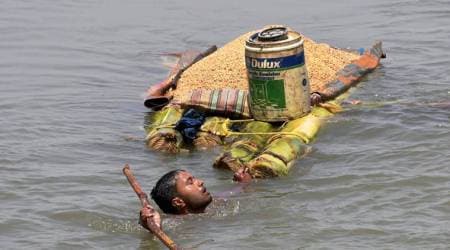 During this year’s floods, the media has paid attention to the large number of animals — including rhinos and lesser known endangered species like hog deer and sambar deer — that have tragically perished (Illustration: C R Sasikumar)
During this year’s floods, the media has paid attention to the large number of animals — including rhinos and lesser known endangered species like hog deer and sambar deer — that have tragically perished (Illustration: C R Sasikumar)
“If I were given one hour to save the planet,” Albert Einstein once said, “I would spend 59 minutes defining the problem and one minute resolving it.” I am often reminded of this statement when considering Assam’s annual encounter with floods. Prime Minister Narendra Modi has recently announced that he would appoint a high-powered committee to find “a permanent solution” for Assam’s recurring flood problem. Einstein’s words will be highly relevant to this task. Much of the defining of the problem will have to happen before this committee is formed; its composition will reflect how the government chooses to define the problem.
Floods have not always been a “problem” for Assam. For centuries, the region has relied on the annual flooding and recession of the Brahmaputra and its tributaries for the productivity of its agriculture and other non-farm activities that sustain rural livelihoods. Following a visit to Assam in 1921, M.K. Gandhi spoke of the “relatively happy” lives of the Assamese. “Their land does not require much cultivation,” he observed.
“The flood waters of the rivers fertilise it, so that the people are able to earn their livelihood with little labour.” Even today, the pervasive sight during the monsoons of bamboo fishing nets and traps fixed on water bodies and submerged agricultural lands makes even the casual visitor aware of the significant role that floods play in rural livelihoods.
During this year’s floods, the media has paid attention to the large number of animals — including rhinos and lesser known endangered species like hog deer and sambar deer — that have tragically perished. But without Kaziranga’s annual rejuvenation by floods when the park is closed to tourists, the landscape and its unique wildlife will not survive. No remedy can put at risk the integrity of the dynamic system that connects the Brahmaputra with its alluvial floodplains where Kaziranga is located, and which explains its unique biodiversity.
Floods are events of nature. But they are not “natural disasters”. Whether a natural event becomes a disaster depends on when and where it occurs. Floods affect the natural and built environments differently. The same flood event can be damaging in a heavily built environment but a boon in a natural environment.
In Assam, the perception of floods as a “problem” is a 20th century phenomenon. British colonial administrators did not think of protection against floods in the 19th century. But they were beginning to eye the low-lying areas of the floodplains of the Brahmaputra as a significant source of potential revenue: As “wastelands”, the vocabulary they used to give away large tracts of land to European tea planters. But unlike those lands, these so-called “wastelands” close to the river were not suited for growing tea.
The idea of flood protection appeared on the policy agenda for the first time in the late 1920s and 1930s when floods began to cause damage to the thriving new crop of jute in those low-lying areas. We know from the work of environmental historians that the peasantry in Assam before the 20th century had settled and cultivated lands in the floodplain away from the riverbed. The lowlands close to the river were used for seasonal cultivation.
It was the demand for new lands to meet the growing requirements of Bengal’s jute industry that led to the policy of settling those lowlands with migrants from east Bengal. The rapid rise of jute production in the early part of the last century coincides with the reclamation of those areas for year-round settlement and the first wave of migration of east Bengali peasants to Assam: The forefathers of today’s Assamese-speaking Miya Musalman community. Flood control appeared on the policy agenda only after the jute crop in the riverine tracts became “flood-prone”.
The Assam earthquake of 1950 raised the bed of the Brahmaputra, and floods began to threaten the built environment of commercially important cities like Dibrugarh and Jorhat. That was the spur behind flood control in the post-colonial period. Building embankments to protect those urban settlements now became a policy priority.
The Assam Embankment and Drainage Act that enables the building and maintenance of embankments “for the purpose of excluding, regulating and retaining water” was adopted by the state assembly in 1953. Assam has since built nearly 5,000 kilometres of flood control embankments, the third most extensive in the country. But while embankments were initially able to protect targeted settlements, they have had many unintended consequences.
The confinement of the river flow because of the embankments has led to higher water levels and increased hydraulic pressure during the monsoon, threatening bank erosion and embankment failures. Embankment breaches are now the major cause of flood devastation in Assam. In some parts of the state, embankments affect areas enclosed by an embankment and those outside very differently, adversely impacting the livelihoods of poorer communities and reinforcing social inequalities.
Public policy-making at its best is “a form of collective puzzlement on society’s behalf; it entails both deciding and knowing”. Solving Assam’s “flood problem” will be a complex balancing act. In order to define the problem satisfactorily, one must carefully consider the history of Assam’s complex encounter with floods.
There are two radically different ways of thinking about floods. Let me put them schematically. Physical scientists have traditionally viewed rivers as carriers of volumes of water and sediment that need to be harnessed by science in the interest of human progress. Floods, in their view, are destructive natural hazards that inflict property damage and human suffering. Few contemporary physical scientists, however, will take that view. For ecologists on the other hand, floods are not disasters. They are key to the health of riverine ecosystems; they benefit both people and wildlife. For many in contemporary Assam, dependence on the river ecosystem is not just a theoretical idea; it is lived reality. Many grassroots activists give voice to their struggles without the ecologist’s vocabulary.
At this point of our history when climate change challenges many of the key assumptions behind past economic policy, both perspectives demand consideration. It will be prudent to define the problem carefully before rushing to find a “permanent solution”. That will be in keeping with Einstein’s wise words on how to go about solving problems.

